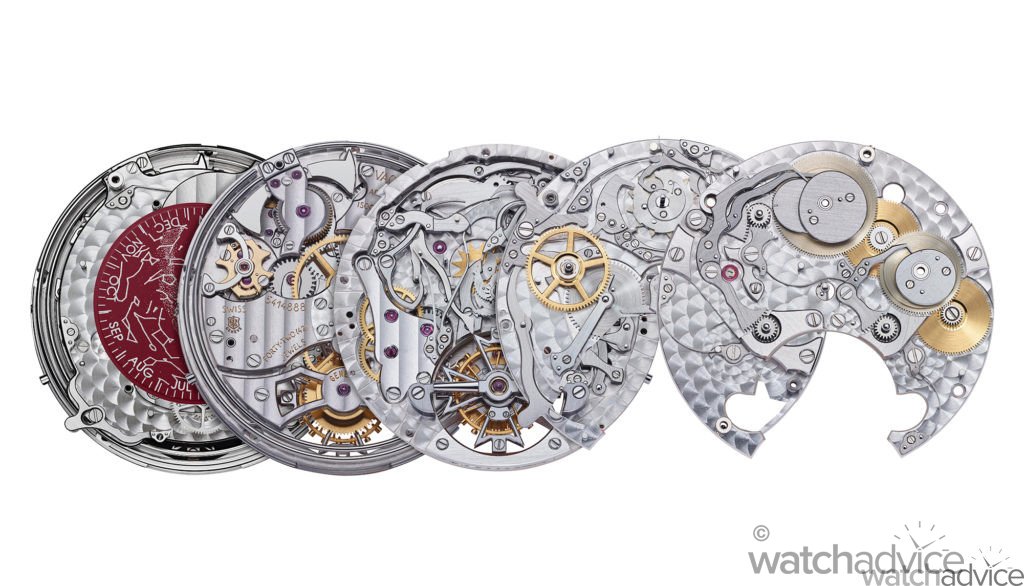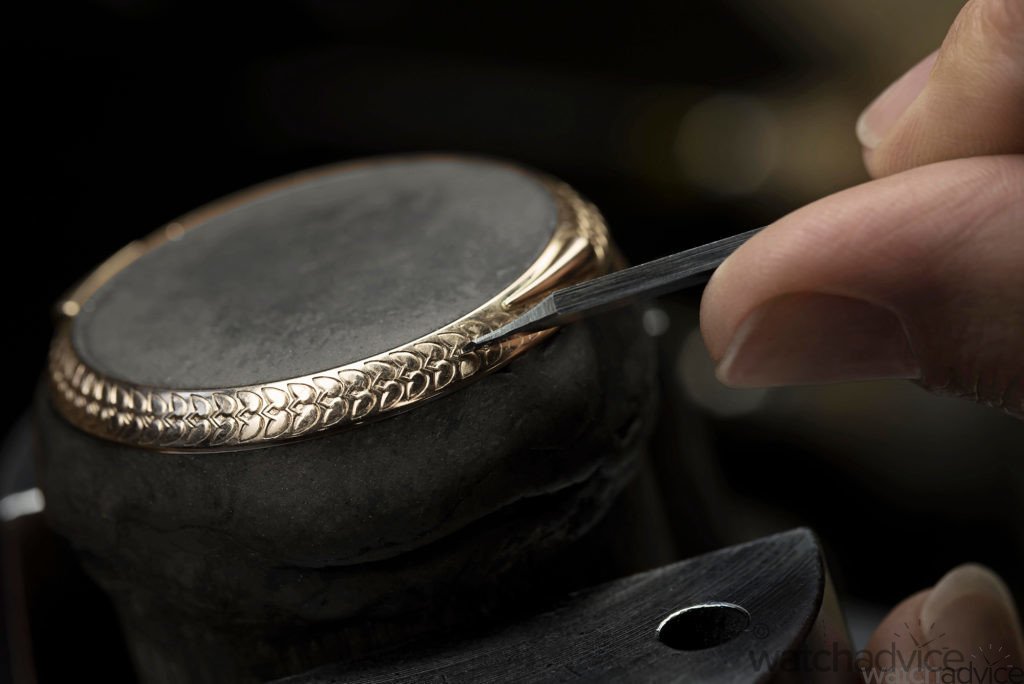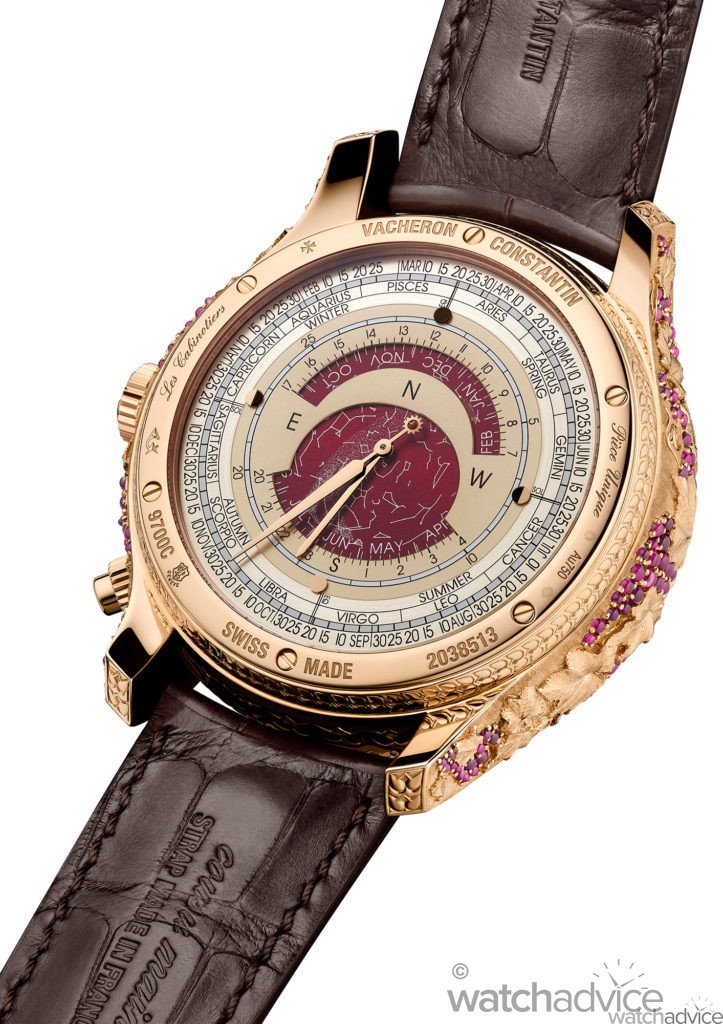Vacheron Constantin’s Les Cabinotiers Grande Complication Bacchus is arguably the most complex watch made by the manufacture. The timepiece features a staggering 16 complications while also being a masterpiece in applied arts. Astronomy and mythology blend in this timepiece to create something unique and truly special. As the name of the timepiece suggests, the word Bacchus is a reference to the mythological god of vines and wine. This is symbolised by the ornamentation of the case with a vineyard motif.
Design:
The Les Cabinotiers Grande Complication Bacchus comes in an 18K 5N pink gold case which as mentioned earlier features a decoration that is composed of vine leaves that is intertwined with bunches of ruby grapes. The gem-setter and master engraver worked together in this progressive duet-style operation which took 300 hours of operation to create this remarkable watch case.
The decoration on the casing continues onto the bezel and case back, with the hand-engraving depicting vine leaves. The engraving effect of the vine leaves gives it a 3D effect on the bezel and matches perfectly with the leaf engraving on the lugs of the watch as well.
The dial is quite complex, yet easy to read once you know the complications involved. The Les Cabinotiers Grande Complication Bacchus has a total of 16 complications! This incredible amount of complications is the most ever done on a watch by Vacheron Constantin.
On the front side of the dial, the beautiful tourbillon can be seen at 6 o’clock. The perpetual calendar functions of the timepiece are offset into three separate counters. At the 3 o’clock position we have the date counter, in the 9 o’clock position we have the day counter and the 12 o’clock counter represents the month. Within the 9 o’clock counter, the power reserve indicator is also housed. Using a serpentine-style hand, it will indicate the power reserve of the watch on the scale located to the left of the counter.
Between 1 o’clock and 2 o’clock on the dial, we can find the hand which indicates the torque of the minute repeater mechanism. Along with the perpetual calendar, leap year, power reserve functions, we also have astronomical functions on the dial side. The first astronomical function can be seen between 10 and 11 o’clock which shows the equation of time. The equation of time is an astronomical reading of time which represents a tribute to Johannes Kepler (1571 – 1630), who discovered the laws of planetary motion.
The last two indicators shown at the bottom of the dial between 3 and 5 o’clock and 7 and 9 o’clock is an extension of the equation of time, more so in this case time correction in astronomical language. The differential is displayed by a pointer with sunrise (7 and 9 o’clock) and sunset times (3 – 5 o’clock).
More complications to this already incredible watch can be seen on the case back. A watch as complex as this would not be complete without a sidereal time indication. This indication can be seen on the case back which comes in the shape of a rotating disc that depicts the celestial vault with its constellations that can be seen from the Northern hemisphere.
How this mechanism works is that a fixed star in the sky is taken as a reference point which is then used to measure the time taken for Earth to complete a full 360° rotation. Known as sidereal day, this is exactly 23 hours, 56 minutes, and 4 seconds. As the Earth is spinning on its own axis and also around the sun, it takes roughly four minutes less than a calendar day to return to the point of origin in relation to the star.
Vacheron Constantin explains that “On this model, the “celestial” disc thus performs a complete rotation according to sidereal time with the time displayed on the periphery, opposite the date appearing on the periphery of the mobile disc. This same date is read off by a large central hand moving over the fixed outer flange bearing a scale graduated in five-day increments. This hand also indicates the sign of the zodiac, the season, and the four dates corresponding to the solstices and equinoxes. Finally, the small central hand indicates the age of the moon, i.e. the number of days that have elapsed since the last full moon.”
Movement:
The movement used inside the Les Cabinotiers Grande Complication Bacchus to power the 16 functions of this timepiece is the brand’s Caliber 2755 GC16 movement. Developed and manufactured fully by Vacheron Constantin, the calibre 2755 GC16 movement is a technological feat as it is comprised of 839 parts that fit into a movement that measures 33.90mm in diameter and 12.15mm thick! The movement operates at a frequency of 18, 000 VpH (2.5hz) and comes with a minimum power reserve of approximately 58 hours. The way Vacheron Constantin has developed this movement to showcase the functions should not go unnoticed either. Normally for a watch with this many features, it would look rather messy on the dial. However, Vacheron Constantin has done an excellent job in making the dial and case back easily legible.

With the release of Les Cabinotiers Grande Complication Bacchus, Vacheron Constantin has brought back age-old tradition of pocket watches, where the pieces were both mechanically complex and beautifully decorated. This latest timepiece makes use of the double-sided display to showcase the essential calendar and astronomical functions and to also show us that Vacheron Constantin is a master of both beauty and function when it comes to watchmaking.











